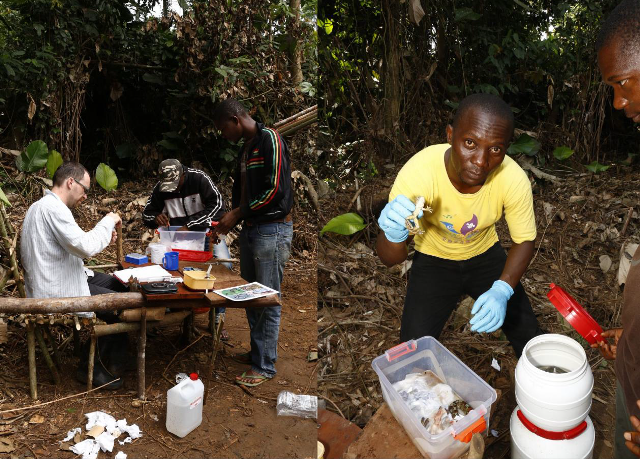 Zoltan Nagy, DR Congo (2014-2015)
Zoltan Nagy, DR Congo (2014-2015)
Diversity assessment of Congolese amphibians and reptiles, building herpetological collections and establishing a new research network in the DR Congo
Abstract:
The herpetofauna of Central Africa, and particularly that of the Democratic Republic of the Congo is still poorly known, species diversity is most likely severely underestimated. In case of reptiles, see Fig. 1, and look at the light brown spot in the middle of the DRC indicating lower diversity, especially in comparison to the Amazonian region. According to a recent assessment on reptiles’ conservation on the global scale (Böhm et al. 2013: The conservation status of the world’s reptiles. Biological Conservation 157: 372-385.), “data deficiency was particularly pronounced in tropical regions, specifically in parts of the Indomalayan realm (...) and Central Africa”.
The RBINS researchers believe that this statement can likely be extended for amphibians, too. They know that several widespread African amphibian and reptile species are present in the DR Congo, but have very scarce information on possible endemics, geographic variations and so on. Nevertheless, in the last few years, several expeditions on smaller scale have been conducted in the country. International collaborations started, first on ad hoc basis, later with using an informal research network. A capacity building program has been built up thanks to funds of the GTI, the Leopold III Fund and the NSF, and with collaboration of Zacharie Chifundera Kusamba (CRSN, Lwiro, DRC). Now the Belgian researchers are aiming at establishing new links and collaborations with young researchers at the University of Kisangani. Offering them a series of trainings and capacity building may help to establish a long-term perspective of herpetological research in the DR Congo.
In 2013, a new collaboration has been started with the University of Kisangani and the ‘Centre de Surveillance de la Biodiversité’ (CSB) through Erik Verheyen (RBINS and University of Antwerp). During a field survey in November 2013, the RBINS researchers identified two persons, Jeannot Akuboy Bodongola and Gabriel Badjedjea Babangenge, as prosperous candidates for a herpetological training. Both of them are very early-stage researchers (i.e., shortly before master degree), but clearly committed to perform herpetological research. Hence, a career at the CSB seems to be a great opportunity for both of them. Nevertheless, a series of training is needed for both persons to improve their theoretical and practical knowledge. Therefore, Dr Nagy proposed a training on site and a field expedition in 2014 that could involve both Jeannot Akuboy Bodongola and Gabriel Badjedjea Babangenge. Their current herpetological interest is complementary (snakes versus frogs, respectively), but they both need to learn some basic techniques and develop their skills. Associated to this, Dr Nagy also aims at improving hard capacities, e.g. by purchasing equipment needed for scientific collection and for depositing voucher specimens and corresponding tissue samples.

Processing specimens in the field lab in the base camp at Bagwase III (left) & mounting specimens of amphibians and reptiles for scientific collection (right) (photos: J. Muratet)

